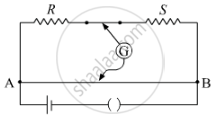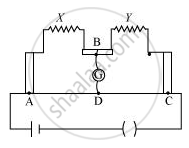Advertisements
Advertisements
प्रश्न
The instrument which can measure terminal potential difference as well as electromotive force (e.m. f.) is ______
- Wheatstone’s meter bridge
- Voltmeter
- Potentiometer
- Galvanometer
उत्तर
(c) Potentiometer
A potentiometer is an instrument used to compare the e.m.f. of two cells or any two sources of e.m.f. If the e.m.f. of one of the sources is known, then the absolute value of the other source can be determined. The potentiometer can also be used to determine the internal resistance of a cell, to measure current, to calibrate an ammeter or voltmeter, to compare resistances, and for measurement of thermoelectric e.m.f.
APPEARS IN
संबंधित प्रश्न
In potentiometer experiment, if l1 is the balancing length for e.m.f. of cell of internal resistance r and l2 is the balancing length for its terminal potential difference when shunted with resistance R then :
State any ‘two’ possible sources of errors in meter-bridge experiment. How can they be minimised?
A potentiometer wire has a length of 4 m and a resistance of 5 Ω. What resistance should be connected in series with a potentiometer wire and a cell of e.m.f. 2 V having internal resistance 1 Ω to get a potential gradient of 10-3 V/cm ?
A cell balances against a length of 200 cm on a potentiometer wire, when it is shunted by a resistance of 8Ω. The balancing length reduces by 40 cm, when it is shunted by a resistance of 4 Ω . Calculate the balancing length when the cell is in open circuit. Also calculate the internal resistance of the cell.
In a meter bridge shown in the figure, the balance point is found to be 40 cm from end A. If a resistance of 10 Ω is connected in series with R, balance point is obtained 60 cm from A. Calculate the values of R and S.

Why are the connections between the resistors in a meter bridge made of thick copper strips?
Why is it generally preferred to obtain the balance point in the middle of the meter bridge wire?
Which material is used for the meter bridge wire and why?
(a) In a metre bridge [shown in the figure], the balance point is found to be at 39.5 cm from the end A, when the resistor Y is 12.5 Ω. Determine the resistance of X. Why are the connections between resistors in a Wheatstone or meter bridge made of thick copper strips?
(b) Determine the balance point of the bridge above if X and Y are interchanged.
(c) What happens if the galvanometer and cell are interchanged at the balance point of the bridge? Would the galvanometer show any current?

When a resistance of 12 ohm is connected across a cell, its terminal potential difference is balanced by 120 cm length of potentiometer wire. When the resistance of 18 ohm is connected across the same cell, the balancing length is 150 cm. Find the balancing length when the cell is in open circuit. Also calculate the internal resistance of the cell.
Write the principle of working of a metre bridge
In a metre bridge, the balance point is found at a distance l1 with resistances R and S as shown in the figure.An unknown resistance X is now connected in parallel to the resistance S and the balance point is found at a distance l2. Obtain a formula for X in terms of l1, l2 and S.

An I0m long uniform metallic wire having a resistance of 20Ω IS used as a potentiometer wire. This wire is connected in series with another resistance of 480Ω
and a battery of emf 5V having negligible internal resistance. If an unknown emf e is balanced across 6m of the potentiometer wire, calculate
1) the potential gradient across the potentiometer wire
2) the value of the unknown emf e.
In a meter bridge, the null point is found at a distance of l1 cm from A. If now a resistance of X is connected in parallel with S, the null point occurs at l2 cm. Obtain a formula for X in terms of l1, l2 and S.


The figure shows experimental set up of a meter bridge. When the two unknown resistances X and Y are inserted, the null point D is obtained 40 cm from the end A. When a resistance of 10 Ω is connected in series with X, the null point shifts by 10 cm. Find the position of the null point when the 10 Ω resistance is instead connected in series with resistance ‘Y’. Determine the values of the resistances X and Y.
In a meter bridge, when galvanometer and cell positions are interchanged, ______.
When a metal conductor connected to left gap of a meter bridge is heated, the balancing point ______.
The metre bridge works on the principle of ______
In a meter bridge experiment, resistance are connected as shown in figure, The balancing length 1, is 55 cm. Now an unknown resistance x is connected in series with P and new balancing length is found to be 75cm. The value of x is ______.

In a sensitive meter bridge apparatus the bridge wire should possess ______.
A meter bridge is balanced with a known resistance (R) in the left hand gap and an unknown resistance (S) in the right hand gap. Balance point is found to be at a distance of 1 cm from the left hand side. When the battery and the galvanometer are interchanged, balance point will ______.
